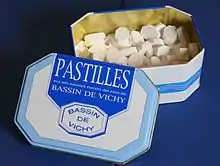Vichy Pastilles
Vichy Pastilles (French: pastilles Vichy), less often pastilles of Vichy (pastilles de Vichy), are a French confectionery produced in the spa town of Vichy in central France. They were invented in 1825. They are recognizable as a white, octagonal type of candy pastille bearing the word "Vichy" in all-caps.
 A box of Vichy Pastilles. | |
| Type | Confectionery |
|---|---|
| Place of origin | France |
| Region or state | Vichy |
Ownership
The Vichy Pastilles brand belonged to the Vichy-État Company in 1940.[1] It was acquired by Cadbury France, a division of Cadbury, in 2003.[2] It later belonged to Kraft Foods (later known as Mondelez International).[2] In 2016, it was purchased by Eurazeo, a French company, for 250 million Euros.[2]
History
The pastilles were invented in 1825 in Vichy, a spa town in the department of Allier, France.[3][4] As early as 1839, they were originally made purely from bicarbonate of soda and taken for their digestive properties.[5] Empress Eugénie de Montijo is said to have been a fan.[3] Later, they were made with mineral salts extracted from the local spring water.[3][6] Nowadays, they include sugar and are flavoured with mint, lemon, or aniseed.[3]
The pastilles were mentioned by French author Guy de Maupassant in his short story, The Magic Couch.[7]
During World War II, the sweets were used as "branding and marketing" by Vichy France.[6] By August 1942, shops in Vichy gave Vichy pastilles to customers, while other victuals were rationed.[8] However, the mayor of Vichy decided to mark sweets as cheese on their ration cards to avoid running out of them.[8]
In Einstein's Beets: An Examination of Food Phobias, American author Alexander Theroux opines that due to its connotation to Vichy France, "many French citizens are still made uneasy" by hearing the phrase.[9] In The Long Aftermath: Cultural Legacies of Europe at War, 1936-2016, Manuel Bragança and Peter Tame agree, as they argue that Vichy France's use of the sweets as propaganda eventually "backfired."[6]
See also
External links
References
- Body, Jacques (1991). Jean Giraudoux: The Legend and the Secret. Madison, New Jersey: Fairleigh Dickinson University Press. p. 114. ISBN 9780838634073. OCLC 869150657.
- Lorut, Denis (April 12, 2016). "Les pastilles Vichy redeviennent françaises". La Montagne. Retrieved October 21, 2017.
- France. Carlton, Victoria, Australia: Lonely Planet. 2017. ISBN 9781786573254. OCLC 983481938.
- Granville, Augustus Bozzi (1859). The Mineral springs of Vichy. London, U.K.: Churchill. p. i. OCLC 504881624.
Vichy Pastilles.
- "Properties of the Blood". The Lancet. 1: 637. 1839. doi:10.1016/s0140-6736(02)83945-9. Retrieved October 21, 2017.
- Bragança, Manuel; Tame, Peter (2015). The Long Aftermath: Cultural Legacies of Europe at War, 1936-2016. New York City: Berghahn Books. p. 136. ISBN 9781782381532. OCLC 946968757.
- "The Magic Couch". The Literature Network. Retrieved October 21, 2017.
- Cointet, Michèle (1993). "La Ville". Vichy capitale 1940-1944 (in French). Paris: Perrin. pp. 93–120. ISBN 9782262010133. OCLC 410952762 – via Cairn.info.
- Theroux, Alexander (2017). Einstein's Beets: An Examination of Food Phobias. Seattle, Washington: Fantagraphics Books. p. 410. ISBN 9781606999769. OCLC 1002177582.